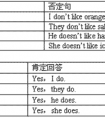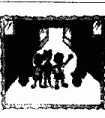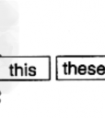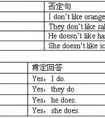— Isthisbackpackyours?— _______________.[ ]A.Yes, itisn'tmineB.No, itismineC.Yes, itismineD.Yes, theyaren'tmine-五年级英语
题文
| — Is this backpack yours? — _______________. |
|
[ ] |
| A. Yes, it isn't mine B. No, it is mine C. Yes, it is mine D. Yes, they aren't mine |
答案
| C |
据专家权威分析,试题“— Isthisbackpackyours?— _______________.[ ]A.Yes, itisn'..”主要考查你对 指示代词,一般疑问句 等考点的理解。关于这些考点的“档案”如下:
指示代词一般疑问句
考点名称:指示代词
指示代词:
是表示指示概念的代词,即用来指示或标识人或事物的代词。
指示代词与定冠词和人称代词一样,都具有指定的含义,用来起指示作用,或用来代替前面已提到过的名词。
指示代词分单数(this/that)和复数(these/those)两种形式,既可作限定词又可做代词,
例如:单数复数
限定词:This girl is Mary.Those men are my teachers.
代词:This is Mary. Those are my teachers.指示代词用法:
1、this和these指在时间或空间上较近的人或者事物,that和those指在时间或空间上较远的人或者事物。如:
This is a pen and that’s an eraser. 这是一支笔,那是块橡皮擦。
This is a boy and those are girls. 这是个男孩,那些是女孩。
2、指示代词所指的对象取决于说话者和听话者共同熟悉的语境。如:
I liked this movie today better than that concert last night.
我喜欢今天的这个电影,胜过昨晚的那个音乐会。
3、指示代词具有名词和形容词性质,既可指人也可指物。但是在相当于名词时一般指物多于指人。如:
I found this wallet. I found this.我找到了这只皮夹子。我找到了这个。(this 等于 this wallet)
Is she going to marry that man?她打算跟那人结婚吗?(that man不得用that代替,否则有轻蔑之意)
4、相当于名词的指示代词在句中作主语时,则指物指人均可。如:
What are these? 那些是什么?(指物)
This is Bill. Is that George? 我是比尔。你是乔治吗?(电话用语)(指人)
5、打电话过程中,介绍自己时通常用this指代“我”,不用代词I;询问对方时用that指代“你”,不用代词you。如:
Hello. This is Mary. Who’s that? 喂,我是玛丽。你是谁?
This is Tom. 我是汤姆。
6、当指示代词所指的事物已确定时,后面的指示代词则用it或they代替。如:
This (suit) is expensive, isn't it? 这套衣服昂贵,不是吗?
"Are those yours?" "Yes, they are." “那些是你的吗?”“是的,它们是我的。”
考点名称:一般疑问句
- 一般疑问句:
是疑问句的一种。它是以be动词,have或助动词、情态动词开头,用yes(是)或no(否)来回答的句子。
其结构是:系动词be/助动词/情态动词+主语+其他成分
一般疑问句的肯定形式为:
助动词+主语(+实义动词)。肯定答语用“yes+可定结构”。
一般疑问句的否定形式为:
助动词构成的缩写否定词+主语(+实义动词)。否定答语用“no+否定结构”。
例:
— Do you like this story-book? 你喜欢这本故事书吗?
— Yes, I do. 喜欢。/ No, I don’t. 不喜欢。
— Is he a student? 他是一名学生吗?
— Yes, he is. 是,他是。/ No, he isn’t. 不,他不是。 一般疑问句的改写:
一、含有be动词的一般疑问句,通常把be动词调到句首。例如:
陈述句:They are in the swimming pool.
一般疑问句:Are they in the swimming pool?
注意:一般疑问句句末要用“?”。
二、含有情态动词的一般疑问句(can, may...),把情态动词调到句首。例如:
陈述句:He can drive a car.
一般疑问句: Can he drive a car?
三、含有have的一般疑问句,have译为“有”。一般疑问句式有两种形式:
1.把have/has调到句首。例如:
陈述句:Tommy has a computer.
一般疑问句:Has Tommy/he a computer?
2.加助动词do/does,第三人称单数用does,其他人称用do。其句型为:Do/Does + 主语 + have...?
例如上句可变为: Does Tommy have a computer?四、一般动词的一般疑问句,也要借助助动词do/does,第三人称单数用does,其余人称用do。
其句型为:Do/Does + 主语 + 动词原形+其它?
陈述句:Amy speaks English.
一般疑问句:Does Amy speak English?一般疑问句的回答:
首先要有人称的改变。当主语为名词时,在答语中要改成其相应的代词。
另外,答语有两种,肯定的回答(用yes)和否定的回答(用no),否定式常用缩写形式。
现在还是让我们分句型一一说明。一、一般疑问句含be动词时,用be动词回答,句末用句号。例如:
-Is Mary your sister?
-Yes, she is. / No, she isn’t.(缩写)二、一般疑问句含有情态动词(can, may, should等)时,用情态动词回答。例如:
-May I come in?
-Yes, you may. / No, you can’t.三、一般疑问句含有have(译为“有”)时,有两种回答方式。
1.直接用have/has回答。
例如:
-Have they any pictures?
-Yes, they have. / No, they haven’t.
2.用助动词do/does回答。
例如:
-Does Millie smoke?
-Yes, she does. / No, she doesn’t.四、一般动词的一般疑问句回答时也用助动词。
例如:
-Do the workers live in London?
-Yes, they do. / No, they don’t.
- 最新内容
- 相关内容
- 网友推荐
- 图文推荐
| [家长教育] 孩子为什么会和父母感情疏离? (2019-07-14) |
| [教师分享] 给远方姐姐的一封信 (2018-11-07) |
| [教师分享] 伸缩门 (2018-11-07) |
| [教师分享] 回家乡 (2018-11-07) |
| [教师分享] 是风味也是人间 (2018-11-07) |
| [教师分享] 一句格言的启示 (2018-11-07) |
| [教师分享] 无规矩不成方圆 (2018-11-07) |
| [教师分享] 第十届全国教育名家论坛有感(二) (2018-11-07) |
| [教师分享] 贪玩的小狗 (2018-11-07) |
| [教师分享] 未命名文章 (2018-11-07) |





